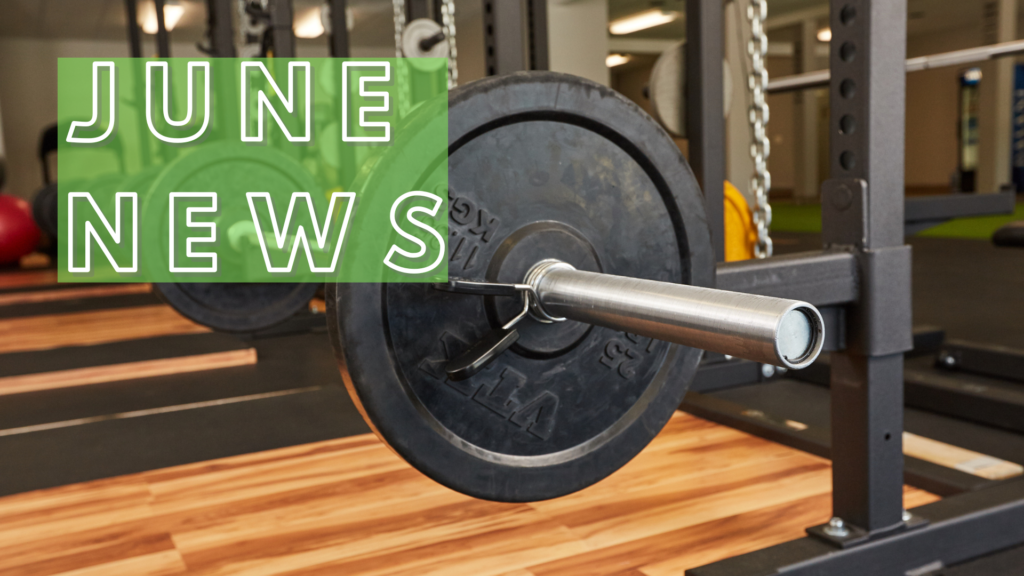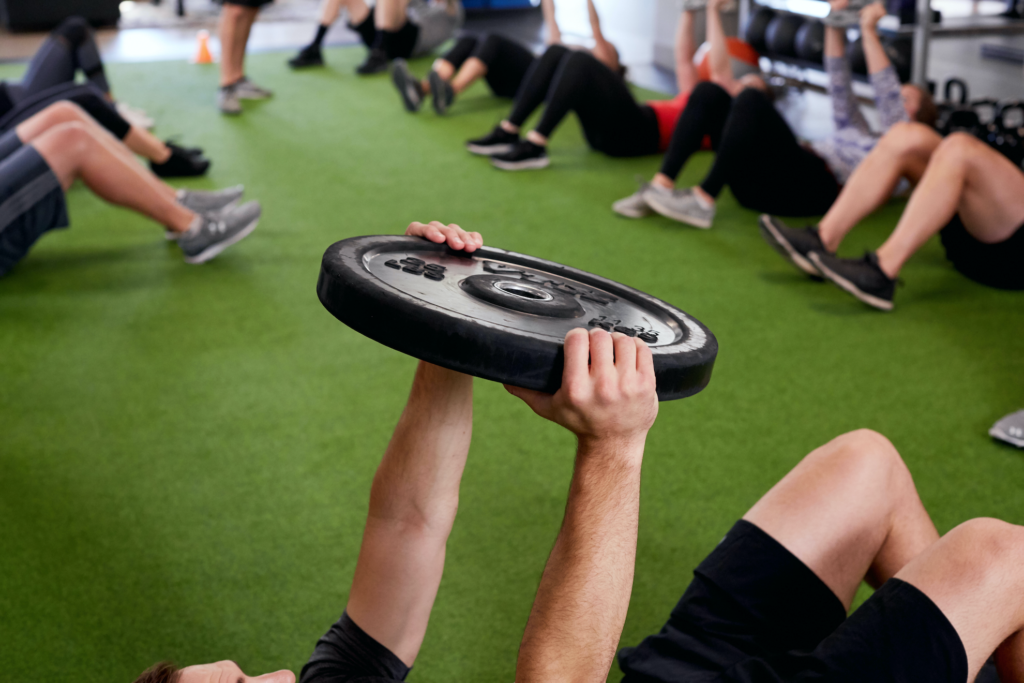
There’s been a lot of hubbub in our neighborhood, and parking-lots, recently! Our surroundings may be changing but, rest assured, we have no plans to move. We can’t thank you enough for your patience and continued attendance during the construction.
In This Newsletter
Current Training Phase
Continuing Your Training During The Summer Months
Housekeeping
Current Training Phase
Deload Week – Prep Week – Max Week
Deload (June 12-16)
Recovering during Deload Week does not necessarily mean taking a break. Through research and experience we have learned we can continue to train while also taking pressure off vulnerable joints like our knees, shoulders, and spine. Continuing to engage certain muscles causes the body to elicit joint recovery more effectively than just resting. (1,2,3,4,7)
Goals for Deload Week!
- Limiting range of motion to ease off vulnerable joints and help them recover.
- Decrease the heavy loading but, as you may have noticed, we increased the number of reps.
- Emphasis on stimulating muscles without causing cellular damage.
- Emphasis on pre-dynamic stretching and movement, post dynamic and static flexibility, mobility and recovery.
- Limit high volume running, cycling, and hiking for this week. High volume training breaks down joints and tissue and we need them to recover.
- Sleep.
Prep (June 19-23)
Post Deload Week, we prep our bodies to ensure they are ready to perform at max effort, the following week. During this week we train the Golgi Tendon Organ (GTO) to prepare for heavy loads above 90% of our 1 rep max. The body uses GTOs to sense weight or muscle tension and if they are not trained, they create a protective response that shuts the body off. This response turns you into Gumby causing you to miss a heavy rep and increases likelihood of injury. Utilizing a week between deload and max effort also allows for the adaptation of strengthening muscles and ligaments, neurological communication, and power output to fully develop. In addition, Prep Week elicits a response called Supercompensation which means our bodies have fully adapted and developed from our 16-week training cycle.
Max (June 26-30)
During Max Week we will be introducing new progressions for the next phase of training. We are focusing on our 1 rep maxes, but we are also focused on developing body composition, movement, bone density, and injury mitigation.
As always, you are not obligated to participate in Max Week. We will have modifications for in season athletes, individuals progressing their lifts, and individuals who want to lift heavy but not max. There is no bonus trophy for achieving your 1 rep max, but it is helpful information, and the body does need to experience stress to get stronger. That said, form and technique must be perfect, especially when lifting heavy. A coach may stop your lift if they see your form breaking down, for your safety. If you injure yourself while maxing out, you will negatively affect your training for the next phase.
REFERENCES:
1-Work, H. D. The Science Behind Deload Weeks Explained.
2-Bell, L., Nolan, D., Immonen, V., Helms, E., Dallamore, J., Wolf, M., & Androulakis Korakakis, P. (2022). “You can’t shoot another bullet until you’ve reloaded the gun”: Coaches’ perceptions, practices and experiences of deloading in strength and physique sports. Frontiers in Sports and Active living, 4.
3-Bosquet, L., Berryman, N., & Mujika, I. (2017). Managing the training load of overreached athletes: Insights from the detraining and tapering literature. In Sport, Recovery, and Performance (pp. 87-107). Routledge.
4-Jacko D, Schaaf K, Masur L, Windoffer H, Aussieker T, Schiffer T, et al. Repeated and interrupted resistance exercise induces the desensitization and re- sensitization of MTOR-related signaling in human skeletal muscle fibers. Int J Mol Sci. (2022) 23:5431. doi: 10.3390/ijms23105431
5-Chiu, L. Z., Barnes, J. L. (2003). The fitness-fatigue mannequin revisited: Implications for planning short-and long-term coaching. Power & Conditioning Journal, 25(6), 42-51.

Importance of Continuing Your Strength & Conditioning Training
During The Summer Months
With the transition in weather comes the transition in our seasonal sports and activities. Running, cycling, and hiking are great ways to train outside of the gym but it’s important to remember that consistently training in the gym will mitigate injury and improve your performance.
Our objectives in the weight room are to (1) strengthen and balance the muscles, ligaments, and tendons so they can adequately handle the stressors of acceleration, deceleration, and change of direction against varying external forces (i.e., ground, snow, water, air, bike pedals, mountain sides, etc.) without breaking down or tearing, and (2) build stamina and endurance to ensure our body can endure repeated stressors for a duration of time.
Fun Fact: The glutes, hamstrings and hip adductors are the primary supporters of the knees and ankles, and produce the most force in acceleration, deceleration, and change of direction. Unfortunately, these muscles are generally not primary muscles worked in sport and are therefore neglected and underdeveloped. This imbalance will eventually lead to performance plateau and decline—if an injury doesn’t occur first! (5,6)
An increased likelihood of injury and decreased performance potential is obviously the opposite of what we’d like to achieve in our sports or activities. To avoid these pitfalls, all strength and conditioning activities need to be reverse engineered sessions of your sport. This is executed by looking at which muscle groups are being activated with participation in any sport or activity, and then have a primary focus on developing and strengthening the other muscles that are not being activated. For example, most sports and activities require heavy quad and hip flexor lower body movements, and heavy flexion and internal rotation of the shoulder joint for upper body movements (1,3). So, the goal in the weight room should be to target the opposite muscles with posterior chain hips, hamstrings, upper back, and external rotation of the shoulder joint. This will balance the body so when participating in sports or activities, these muscles will work together, increasing your horsepower in acceleration, and improving your breaks for decelerations and your body’s handling ability to change direction (1,2,5,6,14).
In summary, the best way to improve your sport performance and decrease likelihood of injury is to incorporate properly periodized and progressive overload-based strength and conditioning (5,6,9,12,14). It’s incredibly important to view this as two separate segments in our training. Combining them into one ultimately decreases your overall success in sport (1,2,6,14,). Fortunately for us all, this is exactly how we program and train at SLC Strength & Conditioning. As long as you’re showing up to train, rest assured, you’re in great hands—regardless of what sport or activity you participate in (or not)!
REFERENCES:
1-Hébert-Losier, K., Zinner, C., Platt, S., Stöggl, T., & Holmberg, H. C. (2017). Factors that influence the performance of elite sprint cross-country skiers. Sports Medicine, 47(2), 319-342.
2-Haugen, T. A., Breitschädel, F., Wiig, H., & Seiler, S. (2020). Countermovement jump height in national-team athletes of various sports: a framework for practitioners and scientists. International Journal of Sports Physiology and Performance, 16(2), 184-189.
3-Losnegard, T., Schäfer, D., & Hallén, J. (2014). Exercise economy in skiing and running. Frontiers in physiology, 5, 5.
4-Castañeda-Babarro, A., Etayo-Urtasun, P., & León-Guereño, P. (2022). Effects of Strength Training on Cross-Country Skiing Performance: A Systematic Review. International Journal of Environmental Research and Public Health, 19(11), 6522
5-Keiner, M., Sander, A., Wirth, K., & Schmidtbleicher, D. (2014). Long-term strength training effects on change-of-direction sprint performance. The Journal of Strength & Conditioning Research, 28(1), 223-231.
6-Lloyd, R. S., Cronin, J. B., Faigenbaum, A. D., Haff, G. G., Howard, R., Kraemer, W. J., … & Oliver, J. L. (2016). National Strength and Conditioning Association position statement on long-term athletic development. Journal of strength and conditioning research, 30(6), 1491-1509.
7-de Hoyo, M., Gonzalo-Skok, O., Sañudo, B., Carrascal, C., Plaza-Armas, J. R., Camacho-Candil, F., & Otero-Esquina, C. (2016). Comparative effects of in-season full-back squat, resisted sprint training, and plyometric training on explosive performance in U-19 elite soccer players. The Journal of Strength & Conditioning Research, 30(2), 368-377.
8-Verkhoshansky, Y., & Siff, M. C. (2009). Supertraining. Moscau, Russia: Verkhoshansky SSTM. 95-105.
9-Delecluse, C. (1997). Influence of strength training on sprint running performance. Sports medicine, 24(3), 147-156.
10-Esfarjani, F., & Laursen, P. B. (2007). Manipulating high-intensity interval training: effects on V˙ O2max, the lactate threshold and 3000 m running performance in moderately trained males. Journal of science and medicine in sport, 10(1), 27-35.
11-Gist, N. H., Fedewa, M. V., Dishman, R. K., & Cureton, K. J. (2014). Sprint interval training effects on aerobic capacity: a systematic review and meta-analysis. Sports medicine, 44(2), 269-279.
12-Girold, S., Maurin, D., Dugue, B., Chatard, J. C., & Millet, G. (2007). Effects of dry-land vs. resisted-and assisted-sprint exercises on swimming sprint performances. The Journal of Strength & Conditioning Research, 21(2), 599-605.
13-McBride, J. M., Triplett-McBride, T. R. A. V. I. S., Davie, A., & Newton, R. U. (1999). A comparison of strength and power characteristics between power lifters, Olympic lifters, and sprinters. The Journal of Strength & Conditioning Research, 13(1), 58-66.
14-Cronin, J. B., & Hansen, K. T. (2005). Strength and power predictors of sports speed. J Strength Cond Res, 19(2), 349-357.
15-Esfarjani, F., & Laursen, P. B. (2007). Manipulating high-intensity interval training: effects on V˙ O2max, the lactate threshold and 3000 m running performance in moderately trained males. Journal of science and medicine in sport, 10(1), 27-35.
16- Kim, J., Lee, N., Trilk, J., Kim, E. J., Kim, S. Y., Lee, M., & Cho, H. C. (2011). Effects of sprint interval training on elite Judoists. International journal of sports medicine, 32(12), 929-934.
Housekeeping
Please be sure to clear dirt and mud off your shoes before coming to class. With everyone enjoying the warmer weather and getting outside, it’s easy to forget the dirt or mud you may have stepped in while enjoying trails.
